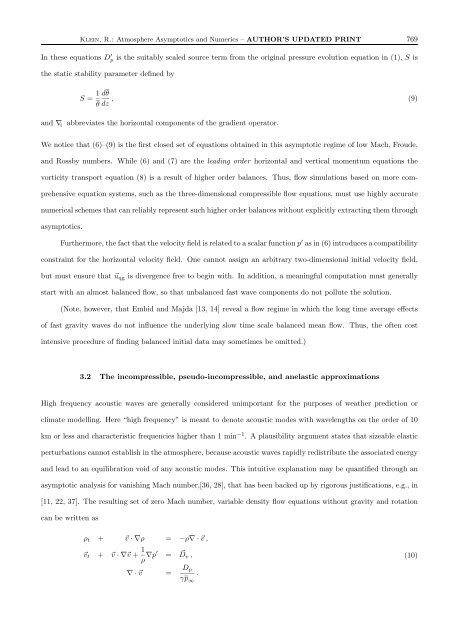Asymptotic Analyses for Atmospheric Flows and ... - FU Berlin, FB MI
Asymptotic Analyses for Atmospheric Flows and ... - FU Berlin, FB MI
Asymptotic Analyses for Atmospheric Flows and ... - FU Berlin, FB MI
Create successful ePaper yourself
Turn your PDF publications into a flip-book with our unique Google optimized e-Paper software.
Klein, R.: Atmosphere <strong>Asymptotic</strong>s <strong>and</strong> Numerics – AUTHOR’S UPDATED PRINT 769<br />
In these equations D ′ p is the suitably scaled source term from the original pressure evolution equation in (1), S is<br />
the static stability parameter defined by<br />
S = 1 θ<br />
dθ<br />
dz , (9)<br />
<strong>and</strong> ∇ ||<br />
abbreviates the horizontal components of the gradient operator.<br />
We notice that (6)–(9) is the first closed set of equations obtained in this asymptotic regime of low Mach, Froude,<br />
<strong>and</strong> Rossby numbers. While (6) <strong>and</strong> (7) are the leading order horizontal <strong>and</strong> vertical momentum equations the<br />
vorticity transport equation (8) is a result of higher order balances. Thus, flow simulations based on more comprehensive<br />
equation systems, such as the three-dimensional compressible flow equations, must use highly accurate<br />
numerical schemes that can reliably represent such higher order balances without explicitly extracting them through<br />
asymptotics.<br />
Furthermore, the fact that the velocity field is related to a scalar function p ′ as in (6) introduces a compatibility<br />
constraint <strong>for</strong> the horizontal velocity field. One cannot assign an arbitrary two-dimensional initial velocity field,<br />
but must ensure that ⃗u qg is divergence free to begin with. In addition, a meaningful computation must generally<br />
start with an almost balanced flow, so that unbalanced fast wave components do not pollute the solution.<br />
(Note, however, that Embid <strong>and</strong> Majda [13, 14] reveal a flow regime in which the long time average effects<br />
of fast gravity waves do not influence the underlying slow time scale balanced mean flow. Thus, the often cost<br />
intensive procedure of finding balanced initial data may sometimes be omitted.)<br />
3.2 The incompressible, pseudo-incompressible, <strong>and</strong> anelastic approximations<br />
High frequency acoustic waves are generally considered unimportant <strong>for</strong> the purposes of weather prediction or<br />
climate modelling. Here “high frequency” is meant to denote acoustic modes with wavelengths on the order of 10<br />
km or less <strong>and</strong> characteristic frequencies higher than 1 min −1 . A plausibility argument states that sizeable elastic<br />
perturbations cannot establish in the atmosphere, because acoustic waves rapidly redistribute the associated energy<br />
<strong>and</strong> lead to an equilibration void of any acoustic modes. This intuitive explanation may be quantified through an<br />
asymptotic analysis <strong>for</strong> vanishing Mach number,[36, 28], that has been backed up by rigorous justifications, e.g., in<br />
[11, 22, 37]. The resulting set of zero Mach number, variable density flow equations without gravity <strong>and</strong> rotation<br />
can be written as<br />
ρ t + ⃗v ·∇ρ = −ρ∇·⃗v,<br />
⃗v t + ⃗v ·∇⃗v + 1 ρ ∇p′ = ⃗ D v ,<br />
(10)<br />
∇·⃗v = D p<br />
γp ∞<br />
.









